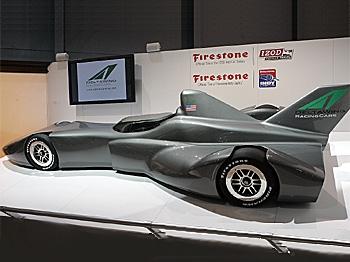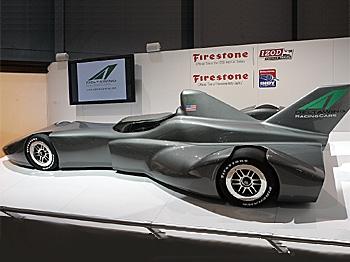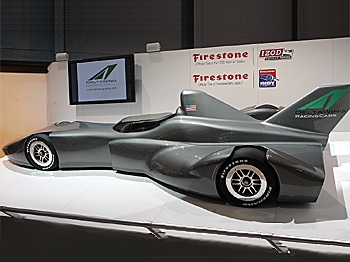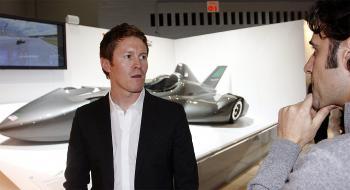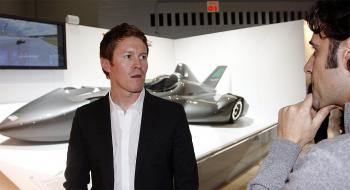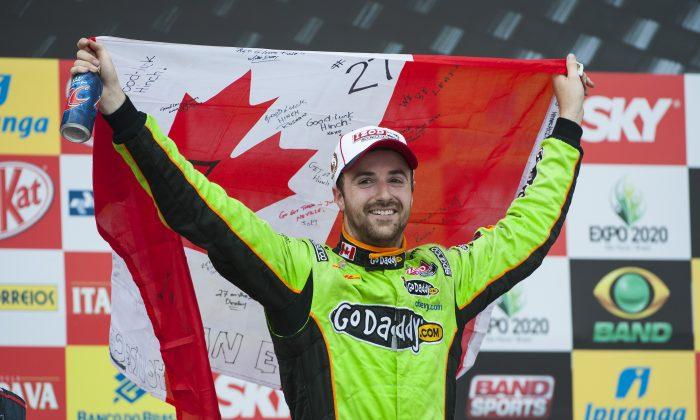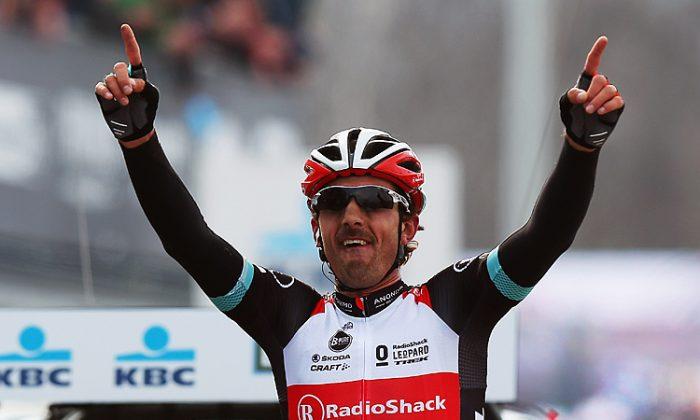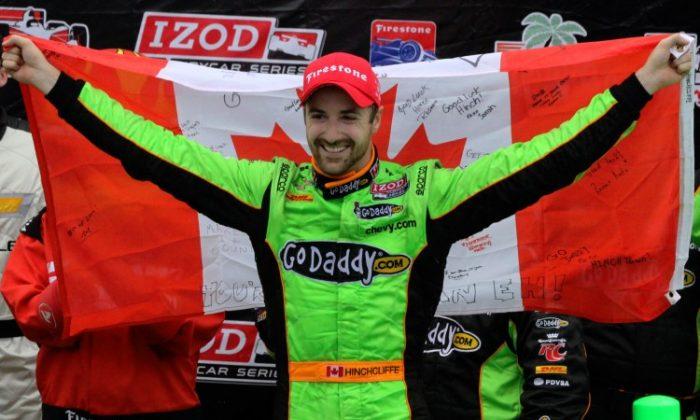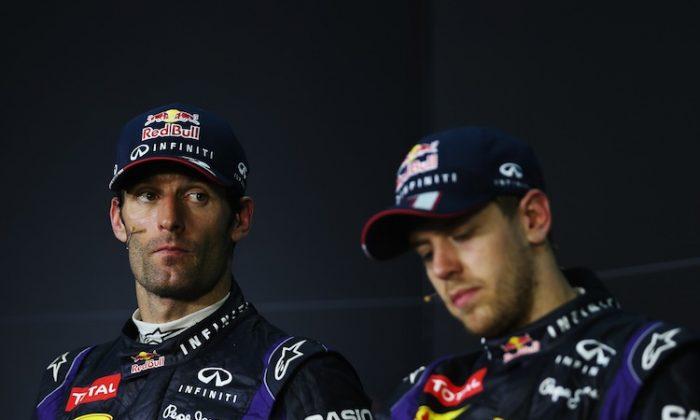After months of debate and anticipation, the Delta Wing group has finally unveiled what it hopes will be the next-generation IndyCar chassis.
The Delta Wing concept car, designed by Ben Bowlby for a consortium of team owners and investors including Roger Penske and Chip Ganassi, is supposed to answer all the faults of the existing car, while improving safety and efficiency.
“Today marks a fundamental shift in how race fans and the general public will view all racing cars in the future; this is a game changer” DeltaWing CEO Dan Partel said on the IndyCar Web site. “This radical prototype takes open-wheel racing to a new level from both an engineering standpoint and the overall spectator experience.”
The new chassis, unveiled for the first time at the Chicago Auto Show, is a radical departure from previous open-wheel designs. The car features a rocket-like fuselage, a narrow front track, a very wide rear end, and no wings, front or rear.
The wheels are almost entirely enclosed, which drastically reduces drag and also increases safety. Open wheel cars in traffic sometimes launch in the air after their tires collide, because the tires spin with so much force.
The tires on the Delta Wing are only half as wide as on the current car, which will also reduce drag, but will also affect traction.
The car supposedly generates all the downforce it needs through underbody ground effects, and is designed to be able to follow closely in traffic, a problem with the old chassis which prevented close racing.
The Delta Wing concept car, designed by Ben Bowlby for a consortium of team owners and investors including Roger Penske and Chip Ganassi, is supposed to answer all the faults of the existing car, while improving safety and efficiency.
“Today marks a fundamental shift in how race fans and the general public will view all racing cars in the future; this is a game changer” DeltaWing CEO Dan Partel said on the IndyCar Web site. “This radical prototype takes open-wheel racing to a new level from both an engineering standpoint and the overall spectator experience.”
The new chassis, unveiled for the first time at the Chicago Auto Show, is a radical departure from previous open-wheel designs. The car features a rocket-like fuselage, a narrow front track, a very wide rear end, and no wings, front or rear.
The wheels are almost entirely enclosed, which drastically reduces drag and also increases safety. Open wheel cars in traffic sometimes launch in the air after their tires collide, because the tires spin with so much force.
The tires on the Delta Wing are only half as wide as on the current car, which will also reduce drag, but will also affect traction.
The car supposedly generates all the downforce it needs through underbody ground effects, and is designed to be able to follow closely in traffic, a problem with the old chassis which prevented close racing.
IndyCar drivers, including current champion Dario Franchitti, former champion Scott Dixon, and rising star Graham Rahal were on hand to see the new concept car.
Dixon gave the car high marks, while Franchitti said he was “ready to drive one,” according to IndyStar.com.
Rahal, quoted on the IndyCar site, said, “The design is revolutionary. We have never seen an open-wheel racing car that looks like this. Is it going to be newsworthy? Yes. Is it going to catch eyeballs? Yes. Plus, there’s good space for sponsors on it.
“From a driver’s point of view, from all the simulations I’ve heard about, the performance of the car is not going to be a concern at all.”
Since 2003, the Indy Racing League (Now called the IZOD IndyCar Series) has been using the Dallara IR3 chassis, which was designed to race only on oval tracks. As the chassis has aged, it has revealed faults: it is not well-suited for road racing, it creates a large turbulent aero wake which prevents close racing, and it is very expensive.
Dallara is located in Italy, and the cost of shipping parts overseas, added to the already high price of the chassis, has driven many IndyCar teams out of business.
The Delta Wing, which will be built by various constructors and parts suppliers in the United States, is supposed to be significantly cheaper to build and buy.
DeltaWing chief technology officer Ben Bowlby, chief engineer for Chip Ganassi Racing and a former Lola chief designer, said the car’s reduced aerodynamic drag and lighter weight would offer high performance on the racetrack with only half the engine power of its recent predecessors, and thus increased fuel efficiency.
Bowlby said he expects to “sell a complete car, including engine, for approximately $600,000.”
“We are confident that this car will outperform the current generation IndyCar and do it in a more environmentally friendly way,” Partel said. “Auto racing has always been a powerful marketing tool for propelling new technology into the hearts and minds of consumers. It is our goal to make participation in the series highly attractive to the automobile manufacturers as well as the fuel, technology, information and entertainment corporate sectors.”
Three other chassis constructors—Swift, Dallara, and Lola—have offered proposals for the next-gen IndyCar chassis. All aim to meet the design criteria laid out by IndyCar management:
Safe: The new chassis must meet existing safety standards while exploring new technology to improve safety in all aspects of the car.
Raceable: The new chassis must continue to produce exciting racing while not affecting other cars on track (i.e. less sensitive to the turbulence).
Cost-Effective: The new chassis must have a price point that lowers cost for the teams.
American-Made: The new chassis must be built in the U.S., preferably at an Indiana-based facility.
Less Mass/More Efficient: A lighter chassis with less mass that produces the same aerodynamic effect in an efficient way.
Relevant Technology: The new chassis should use technology relevant to the future of the consumer auto industry.
Modern Look: The car should have more space for sponsor logos, and be easily identifiable.
Green: The chassis should be more environmentally friendly. (No specifics offered.)
The Delta Wing is the only full-scale mock-up produced by any of the four competing companies.
Delta Wing, formed by team owners who felt that the league was not forward in addressing Indycars’ problems, has been in the works for over a year, while the other competing companies have only released drawings of their proposals. None of the competing designs are as radically different from any other open wheel car ever raced, as is the Delta Wing.
Dixon gave the car high marks, while Franchitti said he was “ready to drive one,” according to IndyStar.com.
Rahal, quoted on the IndyCar site, said, “The design is revolutionary. We have never seen an open-wheel racing car that looks like this. Is it going to be newsworthy? Yes. Is it going to catch eyeballs? Yes. Plus, there’s good space for sponsors on it.
“From a driver’s point of view, from all the simulations I’ve heard about, the performance of the car is not going to be a concern at all.”
Existing Chassis Old and Expensive
Since 2003, the Indy Racing League (Now called the IZOD IndyCar Series) has been using the Dallara IR3 chassis, which was designed to race only on oval tracks. As the chassis has aged, it has revealed faults: it is not well-suited for road racing, it creates a large turbulent aero wake which prevents close racing, and it is very expensive.
Dallara is located in Italy, and the cost of shipping parts overseas, added to the already high price of the chassis, has driven many IndyCar teams out of business.
The Delta Wing, which will be built by various constructors and parts suppliers in the United States, is supposed to be significantly cheaper to build and buy.
DeltaWing chief technology officer Ben Bowlby, chief engineer for Chip Ganassi Racing and a former Lola chief designer, said the car’s reduced aerodynamic drag and lighter weight would offer high performance on the racetrack with only half the engine power of its recent predecessors, and thus increased fuel efficiency.
Bowlby said he expects to “sell a complete car, including engine, for approximately $600,000.”
“We are confident that this car will outperform the current generation IndyCar and do it in a more environmentally friendly way,” Partel said. “Auto racing has always been a powerful marketing tool for propelling new technology into the hearts and minds of consumers. It is our goal to make participation in the series highly attractive to the automobile manufacturers as well as the fuel, technology, information and entertainment corporate sectors.”
Four Factories in Chassis Competition
Three other chassis constructors—Swift, Dallara, and Lola—have offered proposals for the next-gen IndyCar chassis. All aim to meet the design criteria laid out by IndyCar management:
Safe: The new chassis must meet existing safety standards while exploring new technology to improve safety in all aspects of the car.
Raceable: The new chassis must continue to produce exciting racing while not affecting other cars on track (i.e. less sensitive to the turbulence).
Cost-Effective: The new chassis must have a price point that lowers cost for the teams.
American-Made: The new chassis must be built in the U.S., preferably at an Indiana-based facility.
Less Mass/More Efficient: A lighter chassis with less mass that produces the same aerodynamic effect in an efficient way.
Relevant Technology: The new chassis should use technology relevant to the future of the consumer auto industry.
Modern Look: The car should have more space for sponsor logos, and be easily identifiable.
Green: The chassis should be more environmentally friendly. (No specifics offered.)
The Delta Wing is the only full-scale mock-up produced by any of the four competing companies.
Delta Wing, formed by team owners who felt that the league was not forward in addressing Indycars’ problems, has been in the works for over a year, while the other competing companies have only released drawings of their proposals. None of the competing designs are as radically different from any other open wheel car ever raced, as is the Delta Wing.
